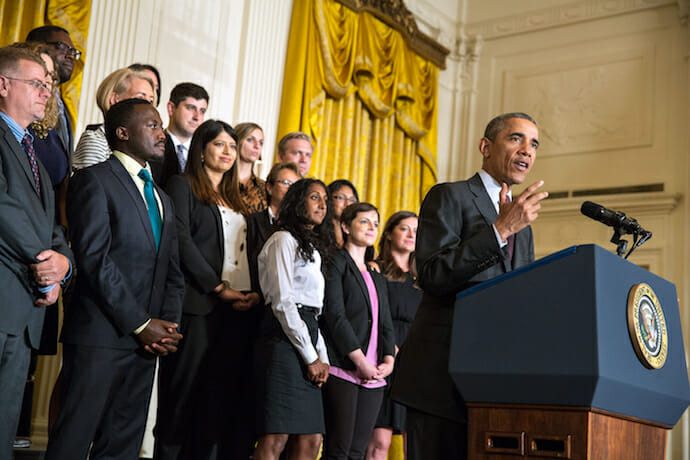
Tech
Solving Government Outsourcing Risks with Private Sector Thinking
For the past several years at various government agencies, there has been a growing gap between the need for Science, Technology, Engineering and Math (STEM) expertise and the availability of this talented group. This dearth of STEM talent is not just a problem existing within the halls of government agencies, a broader shortfall of STEM employees has put pressure on public and private institutions alike.
The Obama administration has enacted numerous policies and allocated funding to STEM-related educational opportunities to encourage more students to pursue these degrees. Research shows that America will need an additional 1 million more STEM graduates by the year 2022 to meet the demand created by our technology-driven economy. While the scarcity of STEM talent affects both sectors alike, the private sector seems to be wining this intellectual tug-of-war.
STEM talent is lured into the private sector for reasons such as higher pay and more readily available innovative opportunities. To solve for this imbalance, the government continually relies on private contractors to meet its needs. Defense contractors designing and building military hardware used in the global theatre and private security firms used during and after the Iraq War to help keep the region safe are examples of the reliance on the private sector, but several risks lie dormant in these arrangements.
Instances of private firms overcharging the government are plentiful; VMware and Carahsoft overcharged the government for technology services in 2015 and certain wireless providers doing the same offer a few sordid examples. We need to look no further than Eric Snowden to see an example of the risks at stake in these partnerships, and the care that must be taken when allowing government contractors to handle classified intelligence. Can some of these contracted technology services be brought in-house at U.S. Government Agencies? Is there a way for the public sector to more effectively compete for STEM Talent so the aforementioned goal can be accomplished?
Just last year, Defense Secretary Ashton Carter crafted a plan where The Department of Defense (DoD) would invest in startups to help develop and utilize the intellectual firepower from young software engineers. While this is a great step towards competing with the private sector for talent, the private sector always seems to be one step ahead. Before Secretary Carter’s initiative was launched, Intel developed a program called Intel Capital. The firm has invested $10 billion in over 1,000 IT startups and launched an online learning program with UC Berkeley, culminating in a business plan contest with $100,000 in prize money for the students. Intel Capital helps generate new ideas for Intel’s own ideas and products, and provides a recruiting supply chain for STEM-related talent at the firm.

Secretary Carter’s effort to invest in startups is valiant, and more efforts are needed in government as private firms like Intel join the fray. The government has the balance sheet and investment horizon/resources to build on these efforts. Defense Advanced Research Projects Agency (DARPA) is one such arrow in the DoD’s quiver. DARPA is not your grandfather’s NASA and Brad Tousley, Tactical Technology Office Leader at DARPA, expressed openly this past spring that his team plans to exceed the technological capabilities of Elon Musk’s SpaceX Program. DARPA’s boldness is a great lure for STEM talent, a true example of government making the public sector “cool” again. Expanding workplace benefits is also key in attracting and retaining talent, something that the private sector is aware of and has invested in heavily.
A 2015 Glassdoor survey stated that 79 percent of workers would prefer new benefits and perks over a simple raise. Similarly, 64 percent of millennials surveyed in a 2015 Aflac Work Forces report cited that a comprehensive benefits package was extremely or very important to employee loyalty. Other workplace perks like work-life integration, wellness programs, family-friendly policies, concierge benefits (time-saving perks like onsite dry cleaning drop-off and pickup), and mentorship programs are examples the public sector can adopt from the private sector.
Similar to Secretary Carter’s initiative, President Obama’s strategy to capture the attention of future bright minds is one that could be duplicated by other agencies. During his tenure he implemented an annual White House Science Fair to showcase the work of young students engaged in STEM across the U.S. Celebrating STEM through these science fairs is a creative way to begin the recruitment process at an early age, allowing these students to see just how much their minds are needed for the public good. In a similar nod to STEM recruitment, the White House held a “Demo Day” last year where 30 tech startups pitched their ideas to The President.
Just as innovative as the aforementioned science fair and “Demo Day” developed by the White House is the “Silicon Valley In-Residence” program. The Executive Office developed this program where workers from Silicon Valley spend a year working on technology projects before returning to their tech jobs. The White House held its 7th annual Global Entrepreneurship Summit in Silicon Valley this summer, further evidence that the government’s desire to innovate and promote entrepreneurship domestically and globally is a serious priority.
Exposing STEM talent to the innovation opportunities in government, in concert with making the government workplace “cooler” again, are two important methods the public sector can use to get an edge in the battle for talent.

